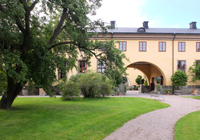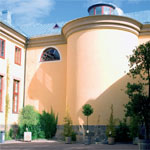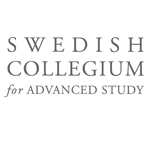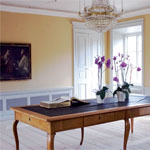
Living in Uppsala
Uppsala is the fourth-largest city in Sweden, with a population of approximately 200,000. It is situated
70 kilometres (45 miles) north of Stockholm.
Housing
The Collegium can provide fellows who do not live in the Stockholm–Uppsala region with accommodation
for the duration of their stay. The housing situation in Uppsala is difficult. However, we are normally able
to secure a number of various-sized sublet flats across the city. We also have one-room flats with a private
bathroom, an adjoining office and a communal kitchen in our "Prefektvilla". In Villa Therese Andersson, we
have somewhat larger flats with a communal kitchen. Please see Housing for further
information.
Day care and schooling
There are several preschools in Uppsala for children aged 1 to 5. Swedish is the language of instruction in
most preschools. The cost is currently (March 2022) no more than SEK 1,572 a month for one child.
There
is a discount for each subsequent child. If your accompanying partner is unemployed or on parental
leave during your stay in Uppsala, you will not be eligible for a full-time preschool place. Please note that
preschool applications need to be submitted at least four months in advance of the anticipated start date.
There is an International School (up to Year 9) in Uppsala, where classes are conducted in English. Tuition
is free, although you have to pay a fee if you wish to have your child enrolled in the after-school programme.
One of the upper secondary schools (for students aged between 16 and 20) in Uppsala offers an English
Immersion Programme (International Baccalaureate Programme). Courses in English are offered to a
limited number of students. As space is limited, it is not always possible to place a child in this programme.
Getting around
Walking and Bicycling
Uppsala has excellent bicycle and pedestrian paths. Fellows may borrow a bicycle and a helmet from the
Collegium for the duration of their stay. A deposit fee will be charged for bicycles.
Driving and Parking
If you wish to drive in Sweden, you will need an International Driving Permit issued in your home country.If you
pay a daily or monthly parking fee, you can park nearby the Collegium. A special parking permit is required.
Public Transportation
A well-developed public transport system provides a number of local and regional bus routes. Several bus routes
pass by near the Collegium.
From Uppsala Central Station, there are daily train services to Stockholm (approximately 40 minutes) in the south
and to towns and cities in the north. Connecting trains to destinations in other parts of Sweden depart from
Stockholm.
Arlanda Airport is situated approximately 36 kilometres (22,4 miles) south of Uppsala and can easily be reached
by public transport (train and airport bus) or taxi.
The City of Uppsala
Notable Buildings
Uppsala domkyrka (Uppsala Cathedral) was consecrated in 1435, but since then it has been reconstructed
several times. Today’s towers are 118.7 metres high and were built in the 1890s. Inside the Cathedral, you
can see, among other things, the coffin of King St Erik and the sarcophagus of King Gustav Vasa. King
Johan III and his wife Katarina Jagellonica, the botanist Carl Linnaeus, Archbishop Nathan Söderblom, the
scientist Emanuel Swedenborg and a number of other famous Swedes are also buried there.
Just opposite the entrance to the Cathedral, you find Museum Gustavianum. It was built in the seventeenth
century and named after the Swedish king Gustav Adolphus II. Under the guidance of Professor Olof Rudbeck,
an anatomical theatre, used for dissecting human bodies in front of an audience, was built on the roof of the
building. The large globe on the very top is a sundial. The building has also in the past served as a university
library. In 1997, the University Museum was opened in the building.
In the park behind Gustavianum lies Universitetshuset (the University Main Building), which was built in the
1880s to accommodate all of Uppsala University’s students. Today the house is still being used for lectures
and seminars, and the Assembly Hall is frequently used for concerts.
Uppsala slott (Uppsala Castle) was commissioned by King Gustav Vasa and originally intended to be a fortress.
Nowadays, the governor of Uppsala County lives in one part of the building. The castle also houses Uppsala
Konstmuseum (Uppsala Art Museum).
A stone’s throw away from the castle you will find the Uppsala University Library Carolina Rediviva.
In addition to being a working research library, there is a small museum where you can see, among other
things, the Codex Argentus (the Silver Bible), which was printed in Gothic by Italian monks around AD 500.
Museums and Parks
Upplandsmuseet (the Uppland County Museum) is situated at St Eriks torg. Here exhibitions on Uppsala and
the county of Uppland are held.
Bror Hjorths Hus (Bror Hjorth’s House) is at Norbyvägen 26, not far from SCAS. The sculptor and painter
Bror Hjorth (1894–1968) was a modernist with roots in folk art. One example of his sculpture work can be
seen outside the central station. His home and studio where he lived and worked with his family for the last
twenty-five years of his life was turned into a museum in 1978. In addition to displaying Bror Hjorth’s
paintings and sculptures, the museum stages several temporary exhibitions every year.
About 4 kilometres (2,5 miles) north of the city centre is Gamla Uppsala (Old Uppsala). In ancient times,
the site was home to a pagan temple, and several pagan kings were buried here 1,500 years ago. The burial
mounds are still visible. At Gamla Uppsala Museum, you can learn more about the history of Old Uppsala
and see what has been found during the excavations of the burial mounds. In Gamla Uppsala, you can also
visit the open-air museum Disagården, which has a collection of houses
dated around 1700.
Botaniska trädgården (the Botanic Garden), where SCAS is located, is the oldest botanic garden in Sweden.
Linneanum and the adjacent Villa are located in the baroque garden. In Linneanum’s south wing, you will find
the orangery, which to this day houses a multitude of
potted plants in winter, including laurel trees that date
back to Carl Linnaeus’ time. In summer, these plants
are found outside Linneanum. A little further down on the
other side of Norbyvägen, you can find the teaching
gardens as well as the tropical greenhouse and a nice café
that is open from May to September.
Linnéträdgården (the Linnaeus Gardens) is at Svartbäcksgatan 27. Here you will find over 1,000 different
plants arranged in flower beds according to Linnaeus’ sexual system of classification. They were laid out in
1655 and called the Botanic Garden of the University. When Linnaeus took over in 1741, he rearranged it
according to his own system. The Linnaeus Museum is located in the garden.
You can also visit Linneaus’
country home, Linnés Hammarby. It is situated 15 kilometres (approx. 9.5 miles)
south-east of Uppsala
and was bought by Linnaeus in 1758.
Stadsträdgården (the City Garden) is situated by the river Fyris. It is perfect for picnics and walks and is in
the very centre of Uppsala.
Stadsskogen (the City Forest) is not very far from SCAS. It is an excellent place
for walks or running.
Entertainment and Sports
FILM, THEATRE and MUSIC
A number of cinemas – showing everything from the latest Hollywood flick to independent films – are located
in central Uppsala. Films are normally shown in the original language with Swedish subtitles. The cinema Fyris
on St Olofsgatan (next to the Main University Building) shows art-house films from a variety of countries.
In central Uppsala, you also find Uppsala Stadsteater (Uppsala City Theatre) and Uppsala Konsert &
Kongress (Uppsala Concert and Congress Hall). Many concerts are also held in the University Main Building’s
assembly hall and in the Cathedral.
SWIMMING POOLS and GYMS
There are a number of sports facilities around Uppsala, both centrally located and in other parts of the city.
Among these is Fyrishov, a large sports centre with swimming pools, a steam bath, a sauna, a gym, etc. In
the city centre, there is Centralbadet, which has a swimming pool, a sauna and a steam bath as well as a
sports club with a gym, spinning bikes, aerobics classes, etc. Uppsala University’s own fitness centres are
Campus 1477 (Blåsenhus and Science Park). Blåsenhus is very close to the Collegium (a five-minute walk)
and offers various forms of exercise, such as aerobics and ball sports, as well as a gym and a climbing wall.
Shopping and Other Services
SHOPPING
The high street is the pedestrian part of Svartbäcksgatan/ Kungsängsgatan (parallel to the river Fyris) on
either
side of Stora Torget and nearby areas. What you would expect to find along a main high street can mostly be
found here: a department store, many large clothes stores, shoe shops, music stores, homeware shops, etc.,
as well as bookshops, small boutiques, cafés, banks, newsstands and more practical stores like a grocery
store and a pharmacy. You can also find a Systembolaget store here (the state-owned alcohol retailer; you
cannot buy spirits, wine or full-strength beer in ordinary grocery stores in Sweden).
In addition to Saluhallen (the Market Hall) and the market at Vaksala torg, there are many small and medium-
sized grocery stores in central Uppsala. Outside the city centre, you will find large shopping centres, home to
clothing stores, shoe shops, electrical retailers, home furnishing stores, pharmacies, postal agents,
Systembolaget stores, banks, etc. These include Gränby Centrum, Stenhagen Centrum and Boländerna.
Some larger low-price grocery stores are also located here.
Services
MOBILE COMMUNICATIONS
Though it is usually not possible to take out a mobile phone contract without a Swedish personal identity number,
you can buy an unlocked phone to use with a pay-as-you-go SIM card. The main Swedish mobile operators all
have shops/service centres in central Uppsala.
BANKING
All major Swedish banks have branches in Uppsala. For currency exchanges, there are foreign exchange
bureaus in central Uppsala. Most stores accept Visa or MasterCard, and if you need money, there are cashpoints
throughout the city. The closest ones to SCAS are at Ica Folkes Livs in St Johannesgatan and on Drottninggatan, down the hill from Carolina Rediviva.
POST OFFICES
While there are very few actual post offices, you can send mail and packages and buy stamps at most
grocery stores and newsstands – look for a blue sign with a yellow horn and crown for full-service centres,
and a blue sign with a yellow stamp for shops selling stamps.
OTHER SERVICES
There are several tailors (skrädderi), dry-cleaners (kemtvätt) as well as shoe repair shops (skomakeri)
throughout Uppsala. Also, there are numerous hairdressers etc.
Destination Uppsala, the Uppsala Tourist Board, provides further information about the city, see Destination Uppsala
The SCAS staff will also be happy to give advice on what to do and where to go.






